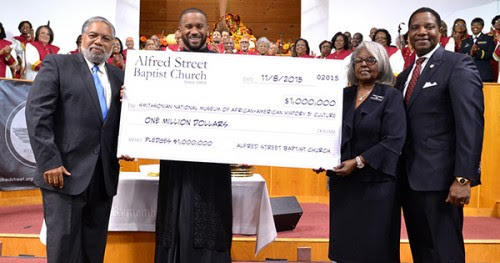
by Lori Lakin Hutcherson (@lakinhutcherson)
Come Friday, we can all watch the seeds of the future, stand-alone Oprah Winfrey Museum be sown.
Opening June 8 and running through June 2019, the “Watching Oprah: The Oprah Winfrey Show and American Culture” exclusive exhibit at the Smithsonian’s National Museum of African American History and Culture will, according to The Washington Post, feature video clips, interview segments, movie costumes, and personal photographs and journals to explore what has influenced Winfrey and how her work has shaped America.
“What’s interesting is the same way America thought about Walter Cronkite — you could trust Walter Cronkite and his opinion — they trust Oprah,” said museum director Lonnie G. Bunch III. “An African American woman becomes the person America turns to.”
Winfrey donated $12 million to the $540 million museum as it was being built, making her its largest individual benefactor (its theater is named in her honor). But her role as benefactor did not influence the exhibition, Bunch said. “We made sure there was a bright line, that this was done by the museum and museum scholars,” he said. “The fundraising was not through Oprah’s people.”
Curators Rhea L. Combs and Kathleen Kendrick worked with Winfrey and her staff on arranging loans for the exhibition and on fact-checking and background information. “In terms of content and narrative and the way the story is told, it’s the museum’s product,” Kendrick said. “The way we approached it was the way we approach all of our exhibitions.”
The exhibit balances Winfrey’s humble personal story with her achievements. “We’re providing a context for understanding not only who she is, but how she became a global figure, and how she is connected to broader stories and themes,” Kendrick said.
 The first section of the show, which is in the Special Exhibitions gallery, explores Winfrey’s childhood and early career and how the cultural shifts of the 1950s and 1960s informed her worldview.
The first section of the show, which is in the Special Exhibitions gallery, explores Winfrey’s childhood and early career and how the cultural shifts of the 1950s and 1960s informed her worldview.
“Civil rights, the women’s movement, the media and television landscape, she’s at this distinct intersection of all of these dynamic moments,” Combs said. “She becomes someone at the forefront of dealing with ideas, of discussing hot-button topics like racism and sexual orientation.”
The middle section looks at the 25-year run of the “Oprah Winfrey Show,” the highest-rated talk show in U.S. television history. Using artifacts from Winfrey’s Harpo Studios in Chicago, where the show was filmed, this section focuses on its evolution, its variety of subject matter and guests, and its reach into social issues such as racism and equality.
“She used television as a social medium, convening conversations and creating these interactive experiences with people,” Kendrick said. “She’s offering lessons for living, social guidance in a way.”
The third section looks at Winfrey’s role as cultural influencer and tastemaker in the movies she has made (“The Color Purple,” “Beloved,” “The Butler”) the books she promoted in her television book club and her philanthropic work.
The timing of the high-profile exhibition was planned to coincide with the last quarter of the African American Museum’s second year, when officials expected a drop in attendance. Instead crowds are regularly at capacity and timed passes to enter are still required. Since opening Sept. 24, 2016, the museum has welcomed 3.8 million visitors, making it one of the most popular Washington D.C. attractions.
“I really thought after the first year it’d be business as usual, so at the end of the second year I’d do something to give it visibility,” Bunch said. “I didn’t anticipate we’d have the same crush of crowds.”
Bunch said he hopes the exhibition will encourage visitors to think about what Winfrey has represented over the years.
“There are so many issues, about women, power, media, body image,” he said. “This should be a popular show because of the impact of this person, but it is also a show that allows us to think about what it means that a woman who doesn’t fit the TV look could build a media empire and become an entrepreneur.”













